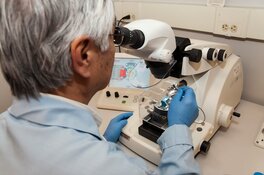The Life Sciences Report: Mark, what disease indication are you exactly going after for patients suffering with back pain?
Mark Weinreb: We have developed a novel cellular therapy and therapeutic delivery device for the treatment of bulging and herniated disc disease. We believe we can effectively and safely treat patients using a nonsurgical, minimally invasive procedure that can be performed routinely in a physician's office. This technology could effectively bridge the gap between noninvasive and surgical back procedures. There are at least one million people, annually, in the U.S. who could benefit from this type of procedure with the promise of avoiding surgery. We elected to pursue this market because of the early success we have seen in several patients who have received this treatment.
TLSR: Can you very briefly describe the technology?
MW: It's a regeneration repair process using a patient's own stem cells, which are implanted using our proprietary delivery device called brtxDISC (Disc Implanted Stem Cells).
TLSR: When can you be in the clinic?
MW: We have data on treated humans in the U.S., and we are now compiling results in preparation for clinical trials in the U.S. Currently, we are reviewing results from 38 patients that had the procedure for bulging and herniated disc disease. We expect to have this retrospective safety analysis of the patients completed during early Q3/13 and intend to meet with the FDA for a preclinical trial discussion. After analyzing and compiling data from this study, we intend to examine the outcomes with the strategy of meeting the FDA requirements and guidelines for filing for a phase 2 investigational new drug application (IND) during Q2/14.
TLSR: Where does brtxDISC technology fit in the spectrum of back pain treatments?
Read Analyst Jason Kolbert's Insights on Investing in the Cell Therapy Space
MW: There are two large surgical markets for back problems. One is the degenerative disc disease (DDD) market, which is where you have collapsed and degenerated discs that would normally be treated with lumbar fusion. We are not in the DDD space. We are first movers in cell therapy in the disc bulge/herniation market, which is now treated with a discectomy. This is a very different problem, where the disc hasn't yet collapsed, but has bulged or herniated and is pressing on a nerve. Currently, there are millions of bulging and herniated disc pain sufferers who will require surgical intervention when conventional, minimally invasive therapies such as physical therapy, steroids or epidurals have failed. Our approach is to repair the disc using cellular therapy and avoid surgery. Our method is nonsurgical and would be performed in the physician's office.
TLSR: You have had the foresight to develop a specialized cannula to deliver cells to the intervertebral space of patients suffering with bulging/herniated discs. It potentially adds value to your cell therapy. But do you run the risk of creating a steeper learning curve for clinicians who are already delivering corticosteroids to the intervertebral space?
MW: Our therapeutic disc device is designed to be used by physicians who routinely perform lumbar discography. This includes a large number of interventional pain physicians. The learning curve should be shallow rather than steep, as the placement of the device in the disc is the same as the standard approach.
TLSR: You are using an autologous (cells from the patient) model. Do you ever think in terms of these cells containing the genotype that produced the bulge/herniation disease, or perhaps a DDD phenotype?
MW: Our proprietary culture process selects a specific cell type that can withstand the harsh conditions within the intervertebral disc. In particular, these cells can survive significant hypoxia. In addition, our cells are from the patient's bone marrow and not a disc, hence we don't have concerns about them being a degenerative disc phenotype. We do not believe that our cells, once transplanted, will have a negative effect in patients. Autologous stem cells are currently being used in numbers of clinical indications, such as cardiac deficiencies with known genetic predispositions, and a negative effect has not been observed.
TLSR: We have not seen any significant immunotoxicity with allogeneic cells (cells from the same species), have we? Why then are you using an autologous model?
MW: We are using this first-generation model based on our previous and continuing analysis of the safety and feasibility study on treated humans, where autologous cells were used. We believe that our therapeutic approach and delivery system is a plug-and-play model, and when next-generation cells become available, whether through our efforts or the efforts of others—including allogeneic cells—they will be able to be used. From a commercial point of view this is what makes our brtxDISC program so attractive, as it allows for the incorporation of new cell types without compromising the overall business model of our therapeutic approach.
TLSR: Mark, many thanks to you.
MW: My pleasure. Thank you.
Mark Weinreb is CEO, president and chairman of BioRestorative Therapies Inc.
DISCLOSURE:
1) George Mack conducted this interview for The Life Sciences Report and provides services to The Life Sciences Report as an independent contractor. He or his family own shares of the company mentioned in this interview: None.
2) BioRestorative Therapies Inc. paid The Life Sciences Report to conduct, produce and distribute the interview.
3) BioRestorative Therapies Inc. had final approval of the content and is wholly responsible for the validity of the statements. Opinions expressed are the opinions of BioRestorative Therapies Inc. and not Streetwise Reports or The Life Sciences Report or its officers.
4) The interview does not constitute investment advice. Each reader is encouraged to consult with his or her individual financial professional and any action a reader takes as a result of information presented here is his or her own responsibility. By opening this page, each reader accepts and agrees to Streetwise Reports' terms of use and full legal disclaimer.
5) From time to time, Streetwise Reports LLC and its directors, officers, employees or members of their families, as well as persons interviewed for articles and interviews on the site, may have a long or short position in securities mentioned and may make purchases and/or sales of those securities in the open market or otherwise.









































